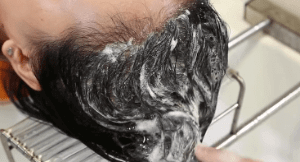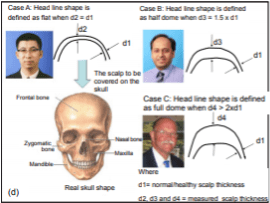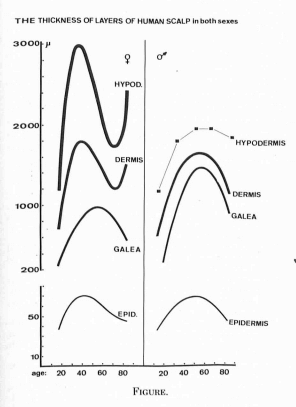I have covered scalp massage, scalp exercises and mechanotherapy for hair growth a number of times on this blog. During the past year, I have had a few people e-mail me about Mr. Robert English and his hair loss treatment protocol. Mr. English owns the perfecthairhealth website. His regimen primarily entails mechanotransduction and scalp massage therapy.
If you do not want to read this entire post, click on the below listed names to go to their approximate sections. I have also covered most of the below people in separate posts in the past.
Important note: I do not believe that any of the below methods can possibly regrow hair on totally bald areas of the head. At best, these scalp massage and related mechanotransduction techniques may make existing thinning hair become thicker. This better quality hair is then less likely to atrophy and progress to baldness.
Also note that even as far back as 1942, a scientist by the name of Frederick Hoelzel made some of the same observations as will be discussed in this post. He came out with a “baldness and calcification of the ivory dome” observation and theory. Make sure to read my post on bald scalps being tighter and thinner.
Scalp Massages and Mechanotransduction
Robert English
Robert English has written two interesting papers on hair loss during the past one and a half years:
- The limitations of just focusing on DHT reduction in dealing with hair loss (February, 2018).
- Survey results from self-assessments of standardized scalp massages for androgenic alopecia (March, 2019).
Neither of the journals that published Mr. English’s papers seem to be prestigious. However, his medical and scientific writing quality is very good. Mr. English does not hold a Phd, and does not seem to have any biology or science background as far as I can tell.
Mr. English mentions the concept of “mechanotransduction” a few times in his first paper. This term encompasses scalp massages and many other forms of mechanical stimulation. I discuss some of these in greater detail in the second half of this post.
A 2016 study from China concluded that:
“Mechanics such as pressure, compression, friction, traction, stretch, shear, and mechanical wounding can influence hair loss or growth.”
Besides improving scalp blood flow and oxygenation, mechanotransduction can alter scalp skin and hair at the genetic level. It can theoretically also reduce hair follicle inflammation, improve nutrient delivery and increase growth factors. Some of these effects seem to occur via Wnt signaling changes. The adverse effects of dihydrotestosterone (DHT) and androgens can be prevented via scalp massage.
A 2016 study from Japan (with Dr. Rei Ogawa as a co-author) concluded that:
“Stretching forces result in changes in gene expression in human dermal papilla cells. Standardized scalp massage is a way to transmit mechanical stress to human dermal papilla cells in subcutaneous tissue. Hair thickness was shown to increase with standardized scalp massage.”
Regimen
It seems like Mr. English’s methodology can only be accessed by joining his membership community and getting his e-book. I have not tried to do either myself. However, someone by the name of JD Moyer wrote a detailed testimonial in 2014 that is worth a read. It looks like Rob English’s method involves: 1) Daily scalp massage; 2) Dietary changes; and 3) Avoidance of using shampoos when washing hair.

I have heard the last mentioned piece of advice many times in the past. I do not believe that shampoos can directly cause scalp hair loss. Otherwise, you would also see body hair loss near your wrists, where the shampoo touches during each scrubbing of the head. Or loss of facial and chest hair, since the shampoo drips down to those areas after rinsing.
Mr. English seems to be saying that the chemicals in shampoos could alter your hormones, which makes some sense. I try not to use my dermatologist recommended dandruff shampoos more than twice a week.
Scalp Exercises, Massages and Mechanotherapy
This post covers the positive hair growth effects from scalp massages, scalp exercises and scalp wounding. Related terms and concepts include mechanotherapy, mechanotransduction and microneedling. Such techniques and treatment that involve direct prolonged contact and manipulation of the scalp are worth linking together in one post. Maybe I should also add Botox injections into the scalp for hair growth into this list.
Scalp massages, stretching and wounding can all perhaps reverse or slow down further progression in scalp calcification and scalp skin fibrosis. Note that the key word here is “perhaps”. I trust the veracity of some of the studies that support these techniques. However, I also have major doubts.
Hair loss is much harder to reverse once calcification and fibrosis pathogenesis have progressed too far. So anything that can reverse or slow down these processes is worth looking into. Scalp tension via the galea aponeurotica is also known to be greater in those suffering from androgenetic alopecia. A number of papers and theories suggest that mechanical stress is involved in male pattern hair loss.
On a side note, there have been many anecdotal reports of people in casts and bandages reporting greater body hair once the cast is removed after several months. Perhaps this is also due to mechanotransduction type reactions?
Of importance, before there was Robert English, there were many others who have discussed similar concepts. Among the main ones that I have covered on this blog in the past include:
Hagerty, Foote, Ogawa and Dhurat
Tom Hagerty
The first one that I heard about was Tom Hagerty. He owns one site on scalp muscle control techniques and hair growth; and another site on face shaping exercises. Mr. Hagerty must be close to 80 years old by now and is still active on his forums. Me and Mr. Hagerty first emailed each other over 15 years ago. His recent videos seem to be done by a younger person:
Stephen Foote
Around the same time or shortly thereafter, I started reading posts from Stephen Foote on various hair loss forums. In 2019, I wrote a post on Stephen Foote and his hydraulic theory of hair loss. His original paper was published in 1995. Mr. Foote makes no income from selling his ideas or any products. He is just a citizen scientist who is now into his 60s.
Rachita Dhurat
Then came various findings from around the world in recent years that concluded that microneedling and wounding benefit scalp hair growth. Perhaps the most famous scientist associated with microneedling and wounding is Dr. Rachita Dhurat from India. Both microneedling and massaging can effect some identical hair growth related pathways and signaling.
Rei Ogawa
Then came Dr. Rei Ogawa and his mechanotherapy theory of hair regeneration. Dr. Ogawa and his Japanese co-researchers have published a number of well regarded papers on scalp massages and mechanotherapy. They seem to have proven that scalp massage can change gene expression at the hair follicle level. I covered both Dr. Rei Ogawa and Mr. Tom Hagerty in a combined post in 2014.
Detumescence Therapy of the Scalp
Hyon-Sook Choy

One person that I never mentioned in the past is Dr. Hyon-Sook Choy. In 2012, he wrote an extremely interesting paper on detumescence therapy of the scalp for hair regrowth. It has some funky photos in there that are well worth a look. After reading Dr. Choy’s work, you might start staring at the shapes of the scalps and foreheads of strangers! I never really thought much about dome shaped heads before reading this paper.
Note: If none of the above works, there is always ligature of the scalp arteries to prevent further hair loss. FYI — I am being sarcastic.
